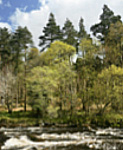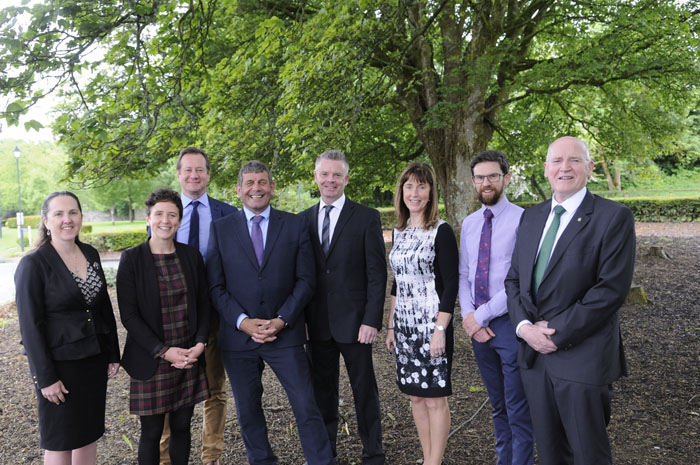![]()


Scottish presence brightens up climate change conference as Minister Gougeon outlines how Scotland has made forestry a priority and “has invested in developing and growing the sector”.
Mairi Gougeon, Scotland’s Minister for Rural Affairs and Natural Environment told delegates at the national forestry conference that “there is a growing understanding that forestry and forests are in the front line of our national response to the climate change emergency that faces us all”. She said: “There is great dynamism in forestry in Scotland at the moment. This is because the Scottish Government has made it a priority and has invested in developing and growing the sector.”
In contrast with Ireland, Scotland has 18.5% forest cover and aims to have 21% of the land under forest and woodland by 2032, while the conference was told that Ireland’s target of 18% forest cover won’t be achieved until well into the next century based on current planting levels.
Minister of State Andrew Doyle opened the conference, organised by the Wood Marketing Federation and the Society of Irish Foresters. The conference explored the central role of forests in climate change mitigation. However, the theme was broadened by speakers including Stuart Goodall, CEO of the UK Confederation of Forest Industries (Confor).
To illustrate this holistic approach, Stuart Goodall presented a case study of a mature forest in South Scotland and examined the carbon benefits along the wood chain; from planting to product. “The carbon stored in the forest is one third of the story,” he said. “More than half as much again is stored in the wood products made from it, but the biggest carbon saving of all is in substitution, because timber is used instead of non-renewable masonry, steel, or fossil fuels.”
In a wide-ranging talk on production forestry and climate change, Marina Conway CEO, Western Forestry Co-op stressed the need to plant “the right species in the right places” and quoting Sir David Attenborough, she said that in many instances the right trees were those planted in commercial plantation forests.
She examined the role of forestry from a global and local perspective. “Halting the loss and degradation of forest ecosystems and promoting their restoration can contribute over one-third of the total climate change mitigation required by 2030 to meet the objectives of the Paris Agreement,” she said. She demonstrated how this can be achieved at a national and local level.
Harvested wood products abate close to one billion tonnes of CO2 but Ireland can improve this further she told delegates. “Even relatively small operations such as McCauley Wood Fuel in Mohill, Co. Leitrim which take in 400 tonnes of timber weekly displace 150,000 litres of heating oil every week. This enterprise is not near full capacity so the benefits for the local economy are enormous as the McCauleys and similar enterprises expand.”
However, in common with other speakers, she said the full potential of forestry will not be realised unless we achieve viable afforestation programmes. This will require a different approach and “may required greater financial incentives” and measures she said, such as:
- Linking to agriculture expansion – opportunity of CAP 2020. “Forest performance under the Carbon Navigator is welcome step but driver is needed”.
- A review of forest land such as unenclosed areas and removing pressure from concentrating the afforestation programme in one province.
- Payment for ecosystem services (PES), in relation to water, carbon and biodiversity.
- Removal of replanting obligation, which can be done without risking deforestation.
- Broadleaf afforestation including pioneer birch woodland but 15 year premium period insufficient. This would need payments for ecosystem services.
She is a strong advocate of broadleaf planting but acknowledges the major role coniferous production forests will play in decarbonising the economy. High production plantation forests complement rather than threaten natural woodlands, she explained. In most instances they provide the only viable source of wood for construction. Quoting Trevor Fenning and Jonathan Gershenzon she said: “Those who oppose plantation forests, need to be clear what the choices really are, rather than what they might like them to be.”

Some of the contributors at the national forestry conference: Marina Conway, CEO Western Forestry Cooperative, Mairi Gougeon, Minister for Rural Affairs and Natural Environment, Scotland’s; Stuart Goodall Confor; Andrew Doyle – Minister of State; Des O’Toole, Coillte and IrBEA; Dr. Mary Ryan, Teagasc; Ken Bucke, President, Society of Irish Foresters and Donal Magner, Wood Marketing Federation.
![]()
Forester, architect and engineer explain the ‘substitution impact’ of wood when used instead of non-renewable masonry, steel, or fossil fuel at the forestry conference
While the recent national conference “Forestry as a climate change solution” explored the role of forests in carbon sequestration, what happens wood after it leaves the forest proved to be just as important in the debate on climate change mitigation. Outlining the Forest Industries Ireland (FII) perspective, Marina Conway, CEO, Western Forestry Co-operative illustrated this point when discussing wood in decarbonising the economy, in construction and agriculture. “Every tonne of timber used instead of cement results in an avoided emission of two tonnes of CO2,” she told delegates.
Mike Haslam, director with Haslam & Co. Architects outlined how his practice’s ethos is design-based on the circular economy “or a cradle to cradle approach where waste equals resource”. He said: “A fundamental part of this is an interest in low embodied energy building and our interest in designing buildings as carbon sinks. At its most basic this acknowledges that one tonne of CO2 locked in per cubic metre of timber is locked in for the life-time of the product.”
He illustrated this with a number of case studies featuring buildings his practice has designed. “Our exploits in timber moved onto post and beam construction at the Airfield Estate in Dundrum using glulam supplied by Cederlan in Cork,” he explained. “Glulam is of interest not only as a carbon sink but also because its strength to weight ratio is better than steel and its embodied energy is five times less than the steel equivalent.”
“For wood products to make a difference in carbon sequestration, enabling fast-growing wood species from temperate regions to substitute for hardwoods is important,” he said. This has relevance for Ireland as a producer of commercial conifers. He cited panel board reconstituted timber products such as long-lasting reconstituted Accoya board used for external cladding and made from conifers, which has the strength and durability of tropical hardwoods.
Des O’Toole, President, IrBEA and Coillte focused on the ‘substitution impact’ of wood. “The ‘substitution impact’ describes how much greenhouse gas emissions would be avoided if wood is used instead of other fossil based products to provide the same function,” he explained. “For example, a tonne of cement emits nearly a tonne of carbon in its making while a tonne of timber, will – through the trees from which it was made – remove up to two tonnes of carbon from the atmosphere.”
An engineer by profession, O’Toole believes that the benefits of increasing general wood use through substitution’ is not understood, capitalised on, or even promoted adequately enough by the sector. “It should be more widely recognised as one of the key drivers in our battle against global warming as we now face a declared climate emergency,” he maintained. He said these benefits are often overlooked or not accounted for in the carbon balance equation. “The forest industry needs to highlight them more effectively with our policymakers and with the general public,” he said. “It is therefore imperative, as the drive to reduce CO2 in construction increases, that we encourage the industry and policy makers to start building with carbon, rather than emitting it.”
He placed emphasis on the major contribution of engineered wood in future construction but solid wood in timber frame housing – now the main structure in north America and Europe – can also make a major contribution to decarbonising the construction industry in the short-term. “It is estimated the average three-bedroom timber-framed house, stores roughly 19 tonnes of CO2, meaning that if Ireland produced all of its 15,700 new homes last year using timber-frame, a total of just under 300,000 tonnes of CO2, would be locked away every year,” the IrBEA President maintained. “At a steady rate of 35,000 new homes per annum – as some analysts suggest we need – this equates to 665,000 tonnes of sequestered carbon. To put all of this in perspective, the carbon embodied in this number of homes, is equivalent to the emissions produced by approximately 370,000 modern cars over a year.”
In addition to construction, he maintained bioenergy had been underestimated in displacing fossil fuel.”The bioenergy sector is a key part of the overall forestry ecosystem,” he said. “As well as contributing to towards Ireland’s ambitious renewable energy targets, the expected growth in demand for biomass will be a key outlet for the increased supply of fibre projected over the next 15 years. The development of local biomass supply hubs will play a role in driving this mobilisation by matching local supply with local demand and providing the best route to market for small wood in first and second forest thinnings.”
PLEASE SEE PRESENTATIONS AND BOOKLET BELOW
Forestry as a climate change solution conference booklet 2019
Part 1 STUART GOODALL Presentation to Irish Conference – May 2019 – Final
Part 2 STUART GOODALL Presentation to Irish Conference – May 2019 – Final
2 MARINA CONWAY presentation at WMF climate change conference
Part 1 MIKE HASLAM timber carbon sink construction
Part 2 MIKE HASLAM timber carbon sink construction
![Wood marketing federation [top]](/wp-content/uploads/2023/12/wood-banner.png)













